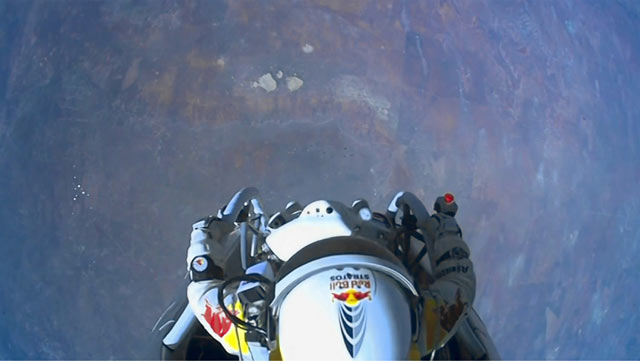Although undeniably a great undertaking, Felix Baumgartner's record-breaking freefall from 120,000ft (36km) on 14 October, when he became the first person to reach supersonic flight outside a vehicle, offers little in the way of data to benefit the scientific community.
Baumgartner jumped from a great height but near-zero velocity, which is of use to neither potential orbital or suborbital launch providers, as both would be moving at orders of magnitude greater speed.
A jump from zero velocity at the edge of suborbital space, around 100km altitude, would have seen him reach speeds of about Mach 4, requiring a suit capable of withstanding much higher entry velocities and freefall time.
There is some benefit to those exploring high-altitude bailouts from aircraft, which travel at a substantially lower speed and altitude than space-bound vehicles. The opportunities to directly observe the impact of such jumps on a human are few and far between. Real-life data is scarce, occasionally provided unplanned by actual high-speed incidents, which often end in fatalities.
 |
Rex Features |
Few crew members are equipped to survive bailouts from the upper corner of the performance envelope. Whereas crews flying aircraft that routinely approach those altitudes and speeds, such as the Lockheed Martin U-2, are essentially equipped with space suits.
The jump from 120,000ft breaks the standing record, set by then-US Air Force captain Joseph Kittinger in 1960. The highest of three jumps saw Kittinger leap from 102,800ft, falling for more than 13 minutes. During freefall he fell at about nine-tenths of the speed of sound.
Kittinger's flight was used to prove a high-altitude parachute system and space suit, clearing the way for use in spaceflight abort procedures and bailouts from high-flying aircraft.
 |
Red Bull/Rex Features |
Kittinger is involved with Baumgartner's Stratos project, remaining in radio contact with him during the ascent.
Among the major risks of the flight were depressurization at altitude, which would have led to near-instant death, and entering a rapid flat spin during descent that could have led to unconsciousness. One unknown was whether Baumgartner's suit would withstand the impact of transonic and supersonic shock waves as he passed through the sound barrier.
Source: Flight International





























